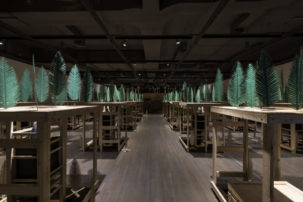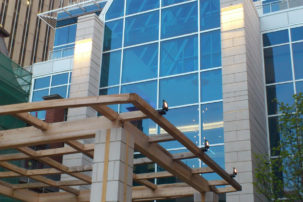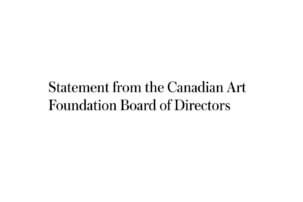A move to hold Banff Centre leadership to account over recent layoffs and visual arts cutbacks—as well as longer-term corporate-arts tensions—is gaining momentum.
“We believe that the Banff Centre belongs to artists, across all disciplines,” says an open letter that began to circulate this week, signed by prominent artists, curators, professors and arts workers. “We call on the leadership of Banff Centre to publicly recommit to the values of supporting the Visual Arts, WPG [Walter Phillips Gallery], and artist-centric operations,” it reads.
Signatories of the letter so far include National Gallery of Canada deputy director and chief curator Kitty Scott, Governor General’s Award–winning artists Rebecca Belmore and Ken Lum, Art Gallery of Alberta executive director and chief curator Catherine Crowston, Canada’s 2017 Venice Biennale exhibitor Geoffrey Farmer and Alberta University of the Arts associate professor Justin Waddell, among hundreds of others.
The open letter comes after mass staff layoffs at the centre. On March 19 of this year, the Banff Centre announced temporary layoffs of 400 people due to the widespread coronavirus shutdowns that, a few days later, closed all of Banff National Park to the public. Then, on June 11—a few days after the park reopened, with restrictions, and three weeks after the Alberta government permitted art galleries to reopen—the centre announced permanent layoffs of 284 staff, with 100 staff still on temporary layoff. Just 123 people of the previous 550-or-so staff remain fully employed.
Banff Centre CEO Janice Price tells Canadian Art that “the majority of those who were impacted by permanent layoffs were in the hospitality and conference area—they are housekeeping staff, food and service staff, and that was the part of our business that disappeared.”
But some in the national and international contemporary art community are concerned that the staff of the centre’s Walter Phillips Gallery—save for one preparator—were also permanently laid off.
“We are deeply concerned about the Centre’s priorities and the vision of [the Banff Centre] leadership,” state University of Queensland Art Museum curator Peta Rake, Esker Foundation curator Shauna Thompson and Katarina Veljovic in a June 13 post to Price and Banff Centre vice-president, arts and leadership, Howard R. Jang, “The announcement of so many layoffs, and the gutting of the Walter Phillips Gallery’s program in particular, is extremely alarming…. I’m sure we don’t need to remind you that, at its core, Banff Centre is an arts organization; it was never meant to be a luxury mountainside conference centre.”
Rake, Thompson and Veljovic had all previously worked in visual arts at the centre—and note that when they worked there in the 2000s, they saw exacerbation of longstanding arts-corporate tensions that stretch back to at least the 1990s.
“We know that the gallery is not particularly valued by the Centre because it is not a revenue generator—and that was explicitly articulated to us while we were there,” says Thompson. “I think there is also a fear that if you turn the lights off even temporarily around COVID, they are not going to come back on.”
More curators, artists and arts workers nationally and internationally have publicly signed on to the cause—often because of the vital role they say the centre has played in their lives and work.
“I don’t think I would be where I am as a curator and writer without those years at the Banff Centre,” Carcross/Tagish curator Candice Hopkins, who signed the open letter, told Canadian Art. Since her years as a curatorial assistant at the gallery (from 2001 to 2005), Hopkins has curated for Documenta 14, the SITE Santa Fe biennial and the 2019 Venice Biennale’s Canada Pavilion.
Yet during her time in Banff, and on more recent visits, Hopkins also perceived “an increasing corporatization of the Banff Centre to the point where it has started to feel [like] artists and guests welcomed through the arts were being treated differently than so-called paying guests [from conferences]. I think that artists had been starting to feel like they had to tread carefully in a space that was made for them.”
If the Centre is to continue during and after the pandemic, “there needs to be a realignment,” says Hopkins. “Right now, it feels like the Centre is going in the absolutely wrong direction by closing the gallery and by defunding the arts, which is its genesis. Any kind of growth has to be sustainable growth.”
Much of the growth of the Banff Centre in recent decades has come through a combination of revenue streams that, until recently, was unlike any other arts institution in Canada. In addition to receiving post-secondary institution funding from the Province of Alberta’s Advanced Education ministry ($20.5 million in 2018, including both base and additional funding, according to the 2018/19 annual report), the Banff Centre receives arts funding from Canadian Heritage, the Canada Council for the Arts and Alberta Culture and Tourism ($3.6 million in 2018). It has access to private and corporate philanthropy and grants ($5.4 million in 2018) and investment earnings ($3.2 million in 2018). And by developing its capacity as a conference-hosting and hospitality business in a popular tourist destination—the Canadian Rockies—it’s built an earned-revenue stream that stood at $30 million in 2018.
“The revenue that came that came in through hospitality and conferences partially supported our arts and leadership programs,” Price says in an interview. “So when that dropped off a cliff in the space of seven days in March 2020, we had to look at how we could retrench.”
Retrenchment, to Price and her team, meant those big June layoffs and program cutbacks. Though the Centre did re-post some archival films and content this spring, as well as curate Spotify playlists and post some artist studio portfolios, the Centre didn’t run many original programs online in late March, April, May and June—save for a June 21 National Indigenous Peoples Day celebration. According to an announcement on the Banff Centre’s website, it’s not until the fall that the Centre will be offering a fuller roster of 14 online programs and events—including at least two for each arts and leadership discipline. In the fall, two major events of the Centre—the Banff International String Quartet Festival and the Banff Centre Mountain Film and Book Festival—will also return online.
“This is a once-in-a-century occurrence,” Price argues of the domino effects of COVID-19, “where 100 per cent of our anticipated hospitality and conference revenues dropped right off the books.”
Some stakeholders in the region are sympathetic to the Centre’s situation—even the union representing many of the Banff Centre’s laid-off employees.
“The hardship in [the Town of Banff] is real and there’s not a lot we can do about it,” says Lou Arab, communications representative for CUPE Alberta, when asked about the impact of local economic context. “Banff as a town is suffering a major drop in tourist revenue because of COVID…. The ski hills closed pretty much when the COVID lockdown began and the problems have just continued—and will probably continue until there is a proper vaccine for COVID-19.”
“We are seeing layoffs in the post-secondary sector throughout Alberta,” Arab also observes, “some of which were caused by COVID, but many of which were caused by a very shortsighted provincial government which is slashing post-secondary in a brutal way.” There are also no conferences going on anywhere in Alberta right now, with gatherings of more than 50 people banned throughout the summer—“this is the bread and butter of the Banff Centre’s business model,” Arab notes.
But others in the region are also asking for more accountability from the Banff Centre. “That an institution of this size and stature was totally crippled in a matter of months should raise eyebrows and serious questions about its business model and leadership,” Canmore resident Matthew Goody recently wrote in a letter published in the Rocky Mountain Outlook.
“As one of the largest employers in this area, this is devastating news for Banff and the ramifications will be felt for a long time,” Goody added. “People need to ask questions and hold those responsible accountable.”
By mid-2019, the Banff Centre’s board and leadership were already aware a global economic crisis could severely impact the Centre’s finances and survival.
The Centre’s 2018/2019 annual report stated that “Global and Canadian economic conditions, and a continued weak Alberta economy, could impact Banff Centre’s ability to generate earned and donated revenues,” and included this under the category of “Areas of Significant Risk.” Further, “Poor economic conditions in Canada and globally could have a significant negative impact on the net contribution generated by earned and donated revenues and the extent to which programming is supported by these activities.”
Despite the awareness of potential risks, the Centre had not accumulated any reserve funds—even though it had announced as far back as 2015 that it would do just that.
“We have not yet built a reserve at Banff Centre,” CEO Janice Price admits in an interview. “And we have talked about it since our strategic plan five years ago. And we will be talking about the importance of having a reserve in the future.”
Annual reports show that there were substantial funds flowing through the Centre during this time, and it had a $17 million operating surplus as of March 30, 2019; a small-print note states that those funds went into capital assets (such as buildings and equipment, says a press representative). Banff Centre received $10 million in new funding from Suncor Energy Foundation in late 2018, but that was earmarked for the next five years of leadership programming. The Centre also had, in July 2019, a near-record-breaking summer gala, which raised $1.27 million. That was all dedicated, a release says, to funding specific to artist programs. And the Centre has an endowment that was at $40.5 million in 2018; as with most endowments, access to these funds is severely restricted.
In a follow-up email, Banff Centre communications representatives stated that “over the four year period from March 31, 2015 to March 31, 2019, Banff Centre eliminated $4 million of accumulated operating deficit (after deducting amounts invested in capital assets). Banff Centre was eliminating deficit in order to work towards building a reserve for the future. Unfortunately, COVID-19 hit in fiscal 2020 before this could be achieved.”
Following the March 2020 hospitality revenue crash, the Banff Centre still does have $16.44 million in Government of Alberta Advanced Education base operating grant funding available for 2020/21—yet the Centre didn’t move to online learning quickly this spring, as many post-secondary peers did, nor to online events and programs, as so many arts institution peers did.
“You know, for me, it’s been a wake-up call,” says Price, when asked about the Centre’s slowness to develop online platforms for arts or education this spring. “It feels to me inherently, with so many of our programs, be they dance, opera, music, or visual arts, our default position was always that those are programs most ideally delivered in person versus online.”
There is also a question of volume: this fall, while Banff Centre is launching 14 online programs and two major events, the Alberta University of the Arts in nearby Calgary, which receives similar public base funding for post-secondary education, is planning to run at least 190 course sections (down from 241 last year).
“A lot of what we do here comes from the power of the place, comes from our location, comes from the ability to do a self-directed residency where you can come here, live here,” Price contends. “Our model is really about being a residency, place-based kind of organization—so that’s one reason why I think we really wanted to take our time and make sure that when we did do online delivery it would be authentic and it would serve the artists and participants.”
The Banff Centre will survive, Price says: “Banff Centre will weather this period. It is a process and we will get through it.”
Survive in what manifestation remains a question, though. Other Banff cultural venues are now reopening—especially visual arts ones, where social distancing is more plausible. Banff’s Whyte Museum reopened to the public on July 1, and local commercial gallery Willock & Sax is also looking at reopening this month. As of press time, there is still no announced plan to reopen the Walter Phillips Gallery or rehire gallery staff, even though this is one of the few public arts venues at the Banff Centre that might be safe to reopen.
“I would say we increasingly need to get the word out” about issues at the Banff Centre, says Candice Hopkins. “I think sometimes visual arts are picked on for defunding because there is the belief we won’t speak out. But I think we do need to speak out and reiterate the value of the visual arts at the Centre, including the gallery’s history”—which includes Hopkins’s co-involvement with innovative outreach work with the nearby Morley First Nations settlement.
“These places [art galleries] are civic places and they are made for the public enjoyment of everyone,” Hopkins concludes. “When we think they are being eroded, something we all value is also being eroded.”
Postscript: On July 14, 2020, the Banff Centre published a letter to the artistic community from CEO Janice Price. Price’s letter addresses some of the concerns raised by artists in this article and the July 7, 2020, open letter.
Correction: The original article, in one instance, erroneously stated “Janet Price” rather than “Janice Price.” It also stated that this fall “the Centre will be offering a fuller roster of 14 online programs—including at least two for each arts and leadership discipline.” This has been clarified to “the Centre will be offering a fuller roster of 14 online programs and events—including at least two for each arts and leadership discipline.”

 A view of the Banff Centre and surrounding mountains. Photo:
A view of the Banff Centre and surrounding mountains. Photo: 






